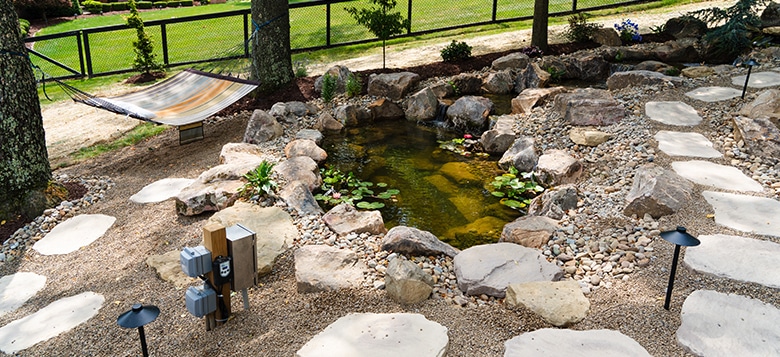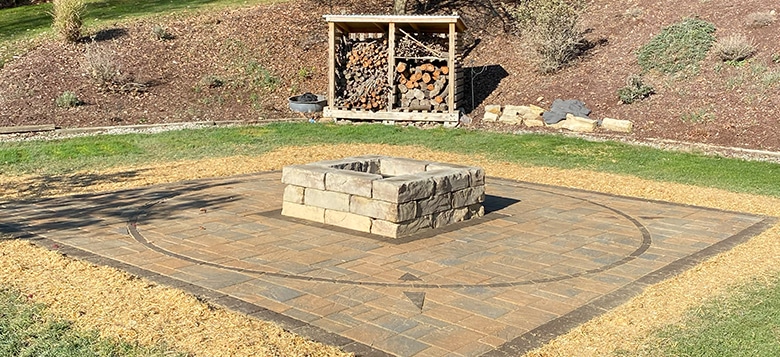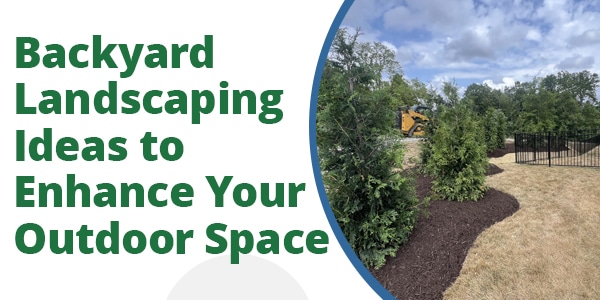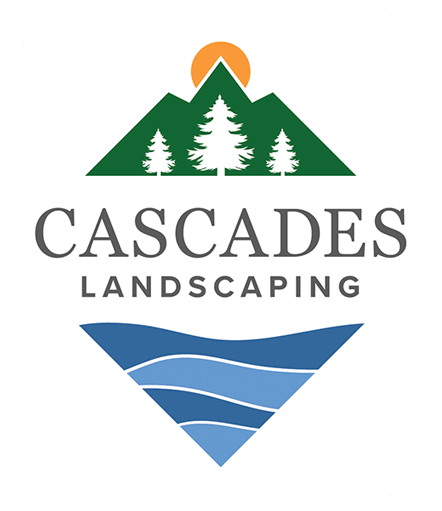Want to upgrade your outdoor space? This backyard landscaping guide offers practical tips on designing, planting, and creating beautiful, functional areas. Learn how to plan your space, choose the right plants, and add hardscaping elements to make your backyard stand out.
Key Takeaways
- Successful backyard landscaping requires careful planning, site evaluation, and the creation of functional zones to enhance usability and aesthetics.
- Choosing the right plants, including native and edible species, promotes sustainability and supports local ecosystems, creating a vibrant outdoor space.
- Incorporating hardscaping elements, lighting, and wildlife-friendly features improves both the functionality and beauty of the backyard while contributing to ecological health.

Planning Your Perfect Backyard Space
Planning is the cornerstone of any successful backyard transformation. Consider how you’ll use your backyard to design a space that fits your lifestyle. Whether you envision a play area, a dining patio, a vegetable garden, or a cozy seating area with a fire pit, take into account your unique style, terrain, budget, and design inspirations.
Improving structural elements of a backyard can significantly enhance its function and aesthetics. Elements like hardscaping, pathways, water features, and seating areas can turn a mundane yard into a beautiful and practical outdoor space. Careful planning and inclusion of these features ensure a backyard that is both stunning and functional.
The first crucial step involves evaluating the site conditions.
Evaluating Site Conditions
Assessing site conditions is pivotal for successful backyard landscaping because it influences plant growth and overall design. Key factors to consider include soil conditions, drainage, and sun exposure, which are crucial for optimal plant growth and effective landscaping.
Testing your soil for pH, consistency, and nutrients before planting helps you understand which plants will thrive in your garden, ensuring a healthy growing environment.
With a clear understanding of your site conditions, you can make informed decisions that will set the foundation for a thriving backyard.
Defining Functional Zones
Dividing your backyard into functional zones is a strategic approach to landscape design. Creating distinct garden rooms for separate functions ensures each area serves a specific purpose, enhancing overall usability. Evaluate the flow, movement, accessibility, and connection between areas to optimize your backyard design.
For families with children, including a dedicated play area is essential. This provides children with a safe and enjoyable play area while adults can relax or entertain elsewhere. A suitable area for outdoor dining, ideally a level lawn under shady trees, creates a perfect spot for al fresco meals.
Custom plans allow for the integration of personal preferences, ensuring that the design reflects your lifestyle and functional needs. Thoughtfully defining and designing these functional zones creates a harmonious and practical backyard space.
Ensuring Privacy
Creating privacy in your backyard enhances comfort and enjoyment. Decorative elements in fencing can improve aesthetics while providing seclusion. Small vining or upright potted plants add visual interest to privacy fences, making them functional and attractive.
Tall plants like hedges create natural barriers for privacy, adding lush greenery to your backyard. In small urban backyards, consider hedging, containers, plant groupings, fencing, or lattice to ensure privacy without compromising space.
With thoughtful planning and the right elements, you can create a private and peaceful retreat in your backyard, allowing you to fully enjoy your outdoor space.
Choosing the Right Plants for Your Backyard
Selecting the right plants is crucial for creating a thriving and visually appealing backyard. Consider the local climate; hardy varieties can handle Pittsburgh’s unpredictable weather. Indigenous plants can significantly reduce water usage and promote biodiversity.
Consider the time you can dedicate to maintaining your garden. Assessing sun exposure helps in selecting appropriate plants. The right plant choices create a beautiful and sustainable outdoor space that flourishes year-round.
Explore the benefits of native plants, flowering plants, and edible gardens.
Native Plants
Native plants enhance biodiversity and support local ecosystems. Well-adapted to the local climate and requiring less maintenance, they are excellent for backyard landscaping. Native plants also attract bees and butterflies, vital for pollination.
A variety of flowering plants can attract beneficial pollinators, creating a vibrant ecosystem. Native plants support local wildlife while providing a low-maintenance and visually stunning garden.
Flowering Plants and Shrubs
A cool-warm color palette of perennials creates a vibrant and inviting atmosphere. Select plants for pathways that do not block the route for better accessibility. A mix of flowering plants and shrubs can attract beneficial pollinators, ensuring a healthy and diverse ecosystem.
These plants add visual appeal and support the local environment. Thoughtfully selecting and arranging flowering plants and shrubs creates a beautiful and functional garden space.
Edible Gardens
Edible landscaping integrates fruits, herbs, and vegetables with ornamental plants for a functional garden. Raised beds or designated areas for vegetable and herb gardens maximize space and accessibility, allowing you to enjoy fresh produce while enhancing visual appeal.
Combining edible plants with ornamental varieties creates a stunning and productive vegetable gardens. Harvesting fresh herbs and vegetables from your backyard adds sustainability and convenience.
Integrating edible gardens into your landscaping creates a beautiful and functional space, providing visual delight and fresh produce for your family.
Hardscaping Elements to Elevate Your Yard
Hardscaping includes non-organic elements like walkways, retaining walls, and patios, significantly enhancing outdoor spaces. These features add structure and functionality, making your yard more usable and aesthetically pleasing. Boundaries defined by elements like plants, fences, or structures can enhance seating areas.
Gravel-covered garden beds and flower beds with plants can frame outdoor spaces for added aesthetic appeal, including a garden border. Explore key hardscaping elements that can elevate your yard.
Stone Patios and Pathways
Stone patios and pathways offer durability and aesthetic appeal, making them a popular choice for backyard landscaping. Emphasize rectangular shapes and long lines, which contrast nicely with taller features. A modern and minimal design style can create a visually appealing natural stone patio that complements your outdoor space.
A cohesive color palette for landscaping can include white, brown, and deep green. Ground cover options like grasses, creeping sedum, or creeping thyme can enhance the look between patio pavers. Preparation should include leveling and choosing between gravel or sand for the foundation, ensuring a stable and long-lasting structure.
Large pavers allow for flexible design options in pathways and patios. Affordable hardscaping materials can create focal points like fire pits or pergolas to complement stone patios, adding both function and beauty to your backyard.
Retaining Walls and Terraces
Retaining walls effectively manage steep landscapes while creating usable garden space. These walls transform sloped areas into flat plots for gardening and other uses. By stabilizing the soil and preventing erosion, retaining walls provide both practical and aesthetic benefits to your yard.
Terraced gardens with stone steps, walking decks, and colorful native plantings add layers of beauty and functionality. These terraces create visual interest and offer additional planting areas, maximizing your backyard’s terrain.
Water Features
Water features like fountains and ponds create a tranquil atmosphere in backyard designs. Adding ponds, fountains, or waterfalls enhances the aesthetic appeal of your outdoor space, promoting relaxation and peace.
A simple birdbath or an elaborate pond can attract wildlife, adding ecological value to your garden. The soothing sound of running water provides a calming backdrop for your outdoor activities.

Creating Cozy Seating Areas
Cozy seating areas enhance relaxation and entertainment in your backyard patio. European patio style, with metal furniture, ornate stone planters, and blooming hydrangeas, creates an appealing and comfortable seating area. Weatherproof furniture like wicker sofas and chairs is crucial for a cozy patio.
Tall mixed hedges provide screening and privacy, enhancing the coziness of the seating area. Potted or climbing plants can frame a seating area, making it feel more intimate in smaller backyards. Container gardens can dress up patios, easily move, and change the shape or look of seating areas as desired.
Maximizing outdoor space with multiple areas for socializing enriches the overall experience. Thoughtfully designing these areas creates a welcoming environment to enjoy the outdoors with family and friends.
Fire Pits and Outdoor Fireplaces
A fire pit or stone fireplace significantly elevates the coziness of an outdoor area. Comfortable seating around an outdoor fireplace encourages bonding and conversation. Custom landscaping allows for unique designs tailored to the homeowner’s lifestyle and preferences.
Creative tiles can personalize an outdoor fireplace. A simple fire feature option is a wood-burning metal fire dish. These elements provide warmth and become focal points for gatherings and relaxation.
Patio Furniture Selection
Weatherproof furniture ensures longevity and functionality in outdoor dining settings. Comfortable seating is crucial for creating a cozy outdoor space for relaxing and entertaining guests.
Choose pieces that are stylish and durable, capable of withstanding the elements while providing comfort. Quality patio furniture creates an inviting and practical seating area, enhancing your outdoor living experience.
Shade Solutions
Shaded areas in your backyard provide comfort during sunny days. A large umbrella can offer shade while enhancing visual appeal. A pergola adds shade and an appealing architectural element.
Planting shade trees naturally provides comfort and reduces heat in your backyard. These trees offer sun relief and contribute to the overall greenery and beauty of your outdoor space. Additionally, it is important to plant trees for long-term benefits.
Combining different shade solutions creates a comfortable and visually pleasing environment.
Enhancing Your Backyard with Lighting
Lighting extends outdoor time into the evening and enhances ambiance. Strategic lighting can create focal points and dramatic shadows with surrounding plants. Various techniques can highlight pathways, garden beds, and architectural features, making your backyard both functional and beautiful.
In-ground lighting for sidewalks and trees or wall-wash lighting for a gentle glow can transform your outdoor space. Explore specific types of lighting that can enhance your backyard.
Landscape Lighting
Pathway lighting increases safety by guiding movement through outdoor areas. In-ground lighting is ideal for illuminating sidewalks and large trees, enhancing safety and aesthetics. Using landscape lighting effectively can highlight pathways and create an inviting atmosphere.
Shadowing emphasizes textures and shapes in garden beds, creating a more dynamic and inviting environment. Highlighting garden beds can draw attention to plants and create a pleasing visual effect. Silhouette lighting enhances interesting shapes by illuminating surfaces behind them, drawing attention.
Grazing technique highlights textures of walls and architectural features, adding depth to the landscape. Wall-wash lighting creates a gentle glow over wide areas to enhance visual appeal with minimal hotspots. Hardscape lighting focuses on features like outdoor kitchens and steps, improving both functionality and aesthetics.
String Lights and Lanterns
String lights can be hung from trees or structures to create a charming and whimsical environment. These lights can create a festive ambiance during outdoor gatherings. Combining string lights with illuminated jars can provide a stunning visual effect for outdoor dining spaces.
Lanterns can be hung or placed on tables to enhance the evening atmosphere. By incorporating these lighting elements, you can create a warm and inviting outdoor space that is perfect for entertaining.
Solar-Powered Options
Solar-powered lights are energy-efficient and easy to install, making them a popular choice for outdoor spaces. These lights can automatically turn on at dusk, providing convenience and energy savings. Solar lights often require no wiring, simplifying the process of adding illumination to any area.
Modern solar lights offer improved brightness and design, making them suitable for various landscaping needs. By choosing solar-powered options, you can enjoy an eco-friendly and hassle-free way to light up your backyard.
Sustainable Landscaping Practices
Sustainable landscaping aims at minimal resource use while maximizing ecological benefits. Using native and biodiverse plants in landscaping offers eco-friendly, low-maintenance solutions that visually enhance outdoor spaces and support pollinators. Incorporating permeable surfaces like stone paths aids drainage and reduces runoff, contributing to water management.
Utilizing compost can improve soil structure and enhance nutrient content, leading to a healthier garden environment. By adopting sustainable practices, you can create a beautiful and environmentally responsible backyard.
Rain Barrels and Irrigation
Collecting rainwater through barrels significantly reduces dependency on municipal water sources. Using rain barrels can help decrease the volume of stormwater runoff and lower the levels of chemicals entering local waterways. Rain barrels can significantly reduce the need for potable water by collecting and storing rainwater for irrigation use.
Applying mulch can help retain soil moisture and reduce the frequency of watering. By incorporating these practices, you can create a more sustainable and water-efficient garden.
Composting and Mulching
Composting enriches soil health by recycling organic waste and improving soil structure. This practice not only enriches soil but also reduces the amount of trash sent to landfills. By composting, you can enhance soil health and promote sustainable practices in landscaping.
Mulching helps retain soil moisture, suppress weeds, and regulate soil temperature, making it an essential component of sustainable gardening. By incorporating composting and mulching into your routine, you can create a healthier and more sustainable garden.
Seasonal Maintenance Tips
Regular maintenance is crucial to keep your backyard healthy and vibrant throughout the seasons. Think about the amount of time you can dedicate to your backyard. Your available time will affect how you manage it. Smart irrigation systems provide many advantages. These include conserving water, lowering maintenance needs, and promoting healthier landscapes.
Incorporating seasonal maintenance tips into your gardening routine can enhance your outdoor space sustainably. Let’s explore specific tips for spring, summer, fall, and winter.
Spring and Summer Care
Regular watering and fertilization are crucial during the warm months to support plant growth. During summer, providing adequate watering and shade for vulnerable plants is crucial to prevent stress from heat.
By ensuring your plants receive the necessary care, you can maintain a healthy and vibrant garden throughout the spring and summer.
Fall and Winter Preparation
In fall, cleaning up dead plant material helps prevent diseases and prepares the garden for new growth in spring. Cleaning up debris and protecting plants from frost are crucial to ensure a healthy start in spring. Winter maintenance includes protecting tender plants from freezing temperatures and pruning deciduous trees.
Applying mulch around perennials provides insulation to protect their roots during cold months. By following these seasonal maintenance tips, you can ensure your garden remains healthy and beautiful year-round.
Incorporating Wildlife-Friendly Elements
Creating a wildlife-friendly backyard helps in preserving local biodiversity and offers shelter to various animal species. By incorporating food, water, and shelter, you can create a habitat that supports local wildlife and enhances the ecological value of your backyard.
Adding birdbaths and small ponds can significantly increase the appeal of a backyard for various wildlife by providing essential drinking water. Simple water features, like shallow dishes, can provide essential hydration for wildlife.
By creating a wildlife-friendly garden, you not only support local ecosystems but also enjoy the beauty and diversity of nature right in your backyard. Let’s explore specific elements like bird feeders, pollinator gardens, and wildlife water sources.
Bird Feeders and Houses
Adding a birdhouse enhances the bird-friendly area of a backyard, providing shelter for local bird species. Bird feeders can attract a variety of birds, adding life and movement to your garden. By providing food and shelter, you can create a haven for birds in your backyard.
These elements not only support local bird populations but also offer you the joy of birdwatching. By thoughtfully placing bird feeders and houses, you can enjoy the sights and sounds of birds throughout the year.
Pollinator Gardens
Pollinator gardens are designed to attract and support essential wildlife such as bees and butterflies, contributing to healthy ecosystems. Employing a 3 x 3 x 3 approach in pollinator gardens involves choosing three native flower species for each of the three growing seasons to ensure continuous bloom.
A continuous bloom is crucial for pollinators, ensuring there are always flowers available for them to feed on throughout their active seasons. Establishing a pollinator garden not only enriches your backyard but also plays a vital role in supporting local biodiversity and promoting sustainability.
By creating a pollinator garden, you can contribute to the health of local ecosystems while enjoying the beauty of colorful flowers and the presence of beneficial insects.
Wildlife Water Sources
Water sources are crucial in attracting wildlife, providing them with essential hydration and a habitat. Birdbaths are an excellent choice for providing a simple yet effective water source for birds in your backyard. Small ponds or water features can create a more diverse habitat, supporting various species of wildlife beyond just birds.
Integrating water features not only supports local wildlife but also enhances the overall beauty and tranquility of your outdoor space. By providing water sources, you can create a welcoming environment for wildlife while enjoying the serene atmosphere they bring.
Working with a Professional Landscape Designer
Hiring a landscape designer can lead to better planning and execution, ultimately saving time and avoiding costly mistakes. Cascades Landscaping focuses on transforming outdoor areas into beautiful, functional spaces through professional design and implementation. Landscape architects create detailed plans that consider both the overall vision and specific details of your outdoor space.
The company emphasizes a collaborative approach, aiming to create outdoor spaces that reflect the client’s personal style. By working with a professional, you can ensure that your backyard landscaping ideas are brought to life with precision and creativity.
Finding the Right Designer
When selecting a landscape designer, consider their portfolio to ensure they have experience with projects that match your desired outdoor activities. It’s crucial to review a designer’s portfolio to ensure their style aligns with your vision and preferences.
Client testimonials can also provide insight into the designer’s ability to meet expectations and deliver high-quality results. By finding the right designer, you can confidently move forward with your landscaping project.
Custom Design Plans
Custom design plans allow homeowners to create a unique outdoor space that reflects their personal style and meets their functional needs. Selecting the right landscape designer is crucial; it ensures that your vision for a custom-designed backyard is effectively communicated and executed.
Managing your budget while planning for custom landscape design helps to balance desired features with affordability. By working with a skilled garden designer, you can achieve a backyard that is both beautiful and functional.
Budget Considerations
Establishing a clear budget early in the design process helps prevent overspending and encourages thoughtful planning of features. Understanding your budget helps the landscape designer suggest appropriate features and manage costs effectively to achieve your dream backyard.
Thoughtful planning based on the established budget ensures that all desired features can be realistically incorporated without exceeding financial limits. Effectively managing your landscaping budget allows for a well-designed space that meets your aspirations without financial stress.
Let’s get started
Ready to transform your backyard into a stunning outdoor space? Cascades Landscaping invites you to reach out via text or call at 412-609-2732 for a personalized consultation on landscaping services. We serve both residential and commercial clients in the greater Pittsburgh area, offering landscaping, hardscape, lawn care, and landscape lighting services.
Don’t wait to create the backyard of your dreams. Contact us today and let us help you bring your vision to life.
Frequently Asked Questions
What types of clients does Cascades Landscaping serve?
Cascades Landscaping serves a diverse clientele, including both residential and commercial clients in the greater Pittsburgh area. This allows them to cater to a wide range of landscaping needs and preferences.
What services does Cascades Landscaping offer?
Cascades Landscaping provides a range of services, including landscaping, hardscaping, lawn care, and landscape lighting. These offerings ensure a comprehensive approach to enhancing outdoor spaces.
How does landscaping affect a home’s value?
Landscaping significantly increases a home’s value by enhancing curb appeal and overall functionality, which makes the property more appealing to potential buyers.
What are some benefits of mature trees and shrubs in landscaping?
Mature trees and shrubs significantly enhance landscaping by reducing energy costs through natural shade and wind protection, improving privacy, and increasing aesthetic appeal, ultimately elevating property value.
What is the commitment of Cascades Landscaping to its clients?
Cascades Landscaping is dedicated to transforming outdoor spaces to align with clients’ visions, creating tranquil and inviting environments for their enjoyment. Call or text 412-609-2732 to start.

